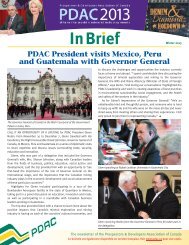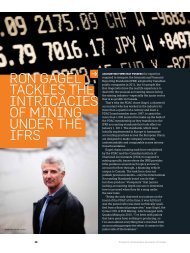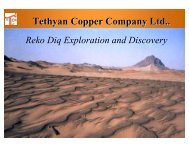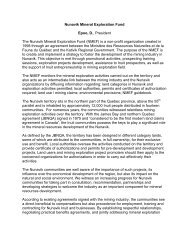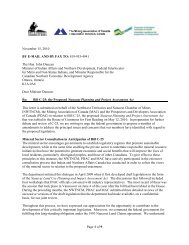The geology of the Relincho porphyry Cu-Mo deposit ... - PDAC
The geology of the Relincho porphyry Cu-Mo deposit ... - PDAC
The geology of the Relincho porphyry Cu-Mo deposit ... - PDAC
Create successful ePaper yourself
Turn your PDF publications into a flip-book with our unique Google optimized e-Paper software.
<strong>The</strong> <strong>geology</strong> <strong>of</strong> <strong>the</strong> <strong>Relincho</strong> <strong>porphyry</strong> <strong>Cu</strong>-<strong>Mo</strong> <strong>deposit</strong>, Atacama Region, Chile<br />
Paul J. Johnston, Teck Resources Limited<br />
Fabian Figueroa, Teck Exploraciones Mineras Chile Limitada<br />
Guillermo Lopez, Gabriel Hernandez & Omar Cortes, Minera <strong>Relincho</strong> Copper S.A.<br />
<strong>Relincho</strong> is a Paleocene <strong>porphyry</strong> <strong>Cu</strong>-<strong>Mo</strong> <strong>deposit</strong> located 45 km east- nor<strong>the</strong>ast <strong>of</strong><br />
Vallenar, Chile at an elevation <strong>of</strong> 1,500-2,100 m in <strong>the</strong> foothills <strong>of</strong> <strong>the</strong> Andean Cordillera.<br />
<strong>The</strong> <strong>deposit</strong> has proven and probable reserves <strong>of</strong> 1,104.5 Mt at 0.41% <strong>Cu</strong> and 0.021%<br />
<strong>Mo</strong>, plus measured and indicated resources <strong>of</strong> 646.1 Mt at 0.32 % <strong>Cu</strong> and 0.013 % <strong>Mo</strong><br />
(Teck Resources Limited, 2012). Sporadic, small-scale mining <strong>of</strong> narrow, high-grade<br />
<strong>Cu</strong>-Au-Ag veins has taken place in <strong>the</strong> district since <strong>the</strong> early 1900’s but systematic<br />
exploration did not commence until 1970, when a Chilean-Romanian consortium<br />
optioned <strong>the</strong> property and began exploring with shafts, adits and drilling. This program<br />
terminated after two years and <strong>the</strong> property remained dormant for <strong>the</strong> next 20 years. In<br />
1993, Outokumpu Chile SA acquired <strong>the</strong> property and completed district and prospectscale<br />
geologic mapping, outcrop sampling, geophysical surveys and 43,028 m <strong>of</strong><br />
drilling. Outokumpu considered <strong>the</strong> project uneconomic and exploration ceased in<br />
1997. Placer Dome acquired <strong>the</strong> property in 2000 and maintained <strong>the</strong> tenure but did not<br />
do any exploration. Lumina Copper purchased <strong>the</strong> property in 2003 and <strong>the</strong>ir<br />
subsidiary, Global Copper SA, began an aggressive exploration program designed to<br />
delineate oxide resources and expand <strong>the</strong> sulphide resource. Teck purchased <strong>the</strong><br />
property from Global Copper S.A. in 2008 and has advanced <strong>the</strong> project to a feasibility<br />
study that is currently in progress.<br />
<strong>The</strong> <strong>Relincho</strong> <strong>porphyry</strong> <strong>deposit</strong> is emplaced into a medium-grained equigranular<br />
granodiorite comprising <strong>the</strong> eastern lobe <strong>of</strong> <strong>the</strong> Los <strong>Mo</strong>rteros batholith, which intrudes<br />
Upper Cretaceous to Lower Paleogene continental sedimentary and volcanic<br />
sequences belonging to <strong>the</strong> Cerrillos and Hornitos Formations (Sergerstorm and Parker,<br />
1959). A K-Ar date <strong>of</strong> 64+/-2 Ma is reported for <strong>the</strong> Los <strong>Mo</strong>rteros Batholith (Abad, 1980)<br />
and a monzogranite dike at <strong>Relincho</strong> returned a K-Ar date <strong>of</strong> 62+/- 2 Ma (Munizaga,<br />
1996). <strong>The</strong> <strong>deposit</strong> is composed <strong>of</strong> coalesced mineralized shells associated with<br />
multiple monzogranite <strong>porphyry</strong> stocks aligned west-northwest with surface dimensions<br />
<strong>of</strong> approximately 2,000 by 700 m. Five distinct <strong>porphyry</strong> phases have been identified at<br />
<strong>Relincho</strong> including two early phases, two late phases, and one post-mineral phase.<br />
<strong>The</strong>se phases have similar compositions and are distinguished by textural differences,<br />
mainly whe<strong>the</strong>r <strong>the</strong> groundmass is aphanitic or very fine grained. Early <strong>porphyry</strong><br />
phases are well mineralized with disseminated and vein-hosted sulphides while <strong>the</strong> later<br />
phases lack appreciable mineralized veins and disseminations. <strong>The</strong> post-mineral phase<br />
is barren. Hydro<strong>the</strong>rmal breccias are associated with both <strong>the</strong> early and late <strong>porphyry</strong><br />
intrusion.
<strong>The</strong> current erosion level exposes predominantly potassic alteration, which is<br />
distinguished by hydro<strong>the</strong>rmal biotite replacement <strong>of</strong> hornblende and primary biotite and<br />
primary feldspar replaced by hydro<strong>the</strong>rmal potassium feldspar. Hydro<strong>the</strong>rmal<br />
potassium feldspar also forms narrow halos to some early quartz veinlets. Potassic<br />
alteration is locally overprinted by weak phyllic alteration recognized by incipient sericite<br />
replacement <strong>of</strong> primary feldspars in granodiorite and <strong>porphyry</strong> phases, along with<br />
sparse sulphide veinlets dominated by pyrite with sericite halos. <strong>The</strong> phyllic event may<br />
also be responsible for partial conversion <strong>of</strong> primary and hydro<strong>the</strong>rmal biotite to chlorite.<br />
Chlorite and epidote characteristic <strong>of</strong> propylitic alteration are ubiquitous throughout <strong>the</strong><br />
<strong>deposit</strong> as replacements <strong>of</strong> primary minerals and in veinlets cutting all inter-mineral<br />
intrusions, indicating a late timing.<br />
Cross- cutting relations show evolution <strong>of</strong> veining over time beginning with early dark<br />
micaceous (EDM) bands composed <strong>of</strong> phlogopite, muscovite and quartz accompanied<br />
by abundant bornite and chalcopyrite. <strong>The</strong>se are cut by aplitic dikes (vein-dikes),<br />
followed by biotite-sulphide veinlets, sulphide-bearing quartz veinlets and finally pyritedominant<br />
sulphide veins with sericitic haloes (D-type veins). Magnetite is present in<br />
some <strong>of</strong> <strong>the</strong> EDM bands and early quartz veinlets. EDM bands are distributed in<br />
equigranular granodiorite around <strong>the</strong> early <strong>porphyry</strong> stocks but are not found within<br />
<strong>the</strong>m. <strong>The</strong> highest quartz vein densities are located in granodiorite immediately adjacent<br />
to <strong>the</strong> early <strong>porphyry</strong> stocks and decline outward. Termination <strong>of</strong> some quartz veinlets<br />
against early <strong>porphyry</strong> contacts suggests some veining and mineralization preceded<br />
intrusion <strong>of</strong> <strong>the</strong> early <strong>porphyry</strong> phases.<br />
<strong>Relincho</strong> displays a typical sulphide mineral zonation from a bornite-chalcopyrite<br />
assemblage in and around <strong>the</strong> early <strong>porphyry</strong> stocks outward and possibly upward to<br />
zones <strong>of</strong> chalcopyrite and chalcopyrite-pyrite. Late <strong>porphyry</strong> phases invariably contain<br />
high pyrite to chalcopyrite ratios. Sulphide zonation is not evident in hydro<strong>the</strong>rmal<br />
breccias, ra<strong>the</strong>r bornite-dominant and chalcopyrite-dominant assemblages that form<br />
cement appear to be associated with discrete hydro<strong>the</strong>rmal breccia-forming events.<br />
References<br />
Abad, E., 1980. <strong>Cu</strong>adrángulos Estación Algarrobal, Yerbas Buenas, Cerro Blanco,<br />
Merceditas y Tres <strong>Mo</strong>rros, Región de Atacama: Instituto de Investigaciones Geológicas,<br />
Carta Geológica de Chile, 1980.<br />
Teck Resources Limited, 2012. 2011 Annual Information Form, Vancouver, Canada,<br />
March 5, 2012, 105p.
Munizaga F., 1996. Informe Geocronológico K-Ar, Prospecto <strong>Relincho</strong>, unpublished<br />
company report prepared for Minera <strong>Relincho</strong> S.A.<br />
Segerstorm K. y Parker R., 1959. Geología del <strong>Cu</strong>adrángulo Cerrillos. Instituto de<br />
Investigaciones Geológicas. Carta geológica de Chile. Vol. I no. 2, 1 mapa, Santiago.





![Fredy Marino.ppt [Read-Only]](https://img.yumpu.com/46988510/1/190x146/fredy-marinoppt-read-only.jpg?quality=85)
